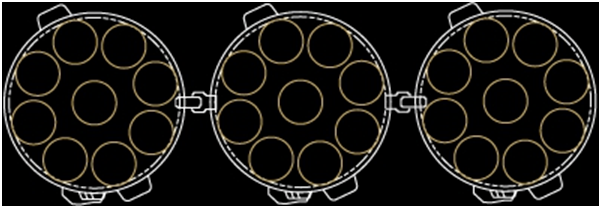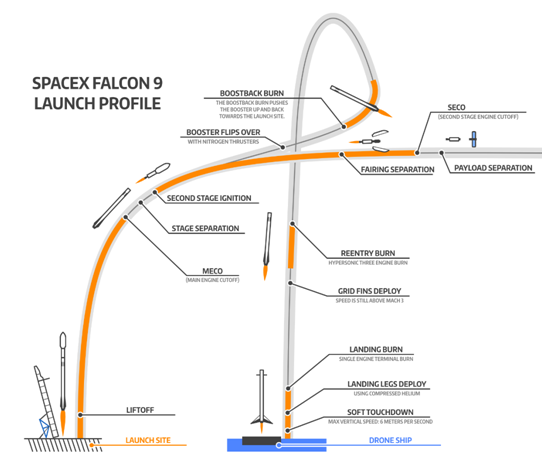Will we ever go to Moon again? Can we take another small step in heavens? Hell Yeah!
The long-awaited Falcon Heavy rocket could blast off on its first flight as soon as November from launch pad 39A at NASA’s Kennedy Space Centre in Florida, returning the stored Apollo- and shuttle-era launch complex to service for the first time since the last space shuttle mission took off in 2011.
Perhaps the most widely-awaited brainchild of billionaire Elon Musk is preparing to be titled the most powerful U.S. rocket to be launched since the Saturns retired in 1972, having twice the capabilities of Space Shuttle and Delta IV heavy.This mammoth of a rocket is an amalgamation of 3 Falcon 9 rockets, with the core stage providing the arrangements for the second stage and the payload faring. It goes well with the concept SpaceX follows, to keep the technology as simple as possible with very less complexities.
At full thrust capability, the Falcon Heavy would be able to lift 54 metric tons (1 metric ton = 1,000 kg), or basically the weight of a fully loaded Boeing 787 jet into orbit. Its first stage has 3 Falcon 9 engine cores, each having 9 Merlin 1D engines. Thus the 27 Merlin 1D engines together generate more than 5 million pounds of thrust at lift-off. For a mere comparison, Space Shuttle Atlantis had a lift-off thrust of 3.5 million pounds, and ISRO’s PSLV C-34, just about 1 million pounds.

A Falcon 9 core with 9 Merlin 1D engines. 2 more core stages are strapped to the interface as boosters. Each engine is capable of providing 845 kN thrust.
The Core Stage stands about 41.2 m tall (for confidentiality reasons, SpaceX hasn’t disclosed the exact dimensions for FH), and about 3.66m in diameter. The configuration shown is known as Octaweb configuration, with the centre nozzle protruding a little to provide aerodynamic stability.
Core Stage and Boosters
The first stage is fed by Chilled Rocket Propellant 1 (high quality Kerosene) as the fuel and sub-cooled liquid oxygen (LOX) as the oxidiser. The core stage and boosters are equipped with a cold-gas reaction control system using Nitrogen for 3 axis control during engine burns.
A very efficient technique adopted by SpaceX is Propellant Densification. To achieve a greater launch thrust, we need to throttle more. And to throttle is to increase the mass flow rate of the fuel in the combustion chamber. To make this more effective, SpaceX has increased the mass that can be loaded into the limited tank volume of the rocket by densifying the propellants by cooling them (mass = density*volume, the greater the density, the greater the mass). SpaceX employs LOX at about -207 Centigrade (general usage is about -183), which increases the oxidiser mass by 15%. Similarly RP-1 cooling to about -7 Centigrade increases fuel mass by 4%.
Each Booster strapped on to the core stage stands at a height of 44.6 m, and when fully filled, weighs around 432 metric tons. Along with the nine Merlin 1D engines, each Booster is equipped with independent guidance, navigation and control systems, along with the Re-entry equipment. One very unique system to be adopted in Falcon Heavy is the Propellant Cross-feed between the boosters and the central core. In simpler words, it means delivering propellants from the oxidiser and fuel tank of the boosters to a number of engines in the core during lift-off, leaving the tanks of central core nearly full till first-stage separation. However, being a very complex technology, this manoeuvre would be used only when the payload is greater than 45 metric tons.
For lesser payloads, SpaceX would be employing the technique of Throttle Down, in which after the initial climb, the central core would throttle its engines down to minimal thrust, while the boosters would continue to fire at full thrust.
The Falcon Heavy supports a second stage very similar to that of Falcon 9. It features a single Merlin 1D Vac engine, which is optimised for operations in vacuum featuring an extended nozzle with a high expansion ration. The higher the expansion ratio, the greater the pressure gradient, the greater is the force, or the thrust. The Payload Fairing consists of an Aluminium Honeycomb Core with Carbon Fibre face sheets fabricated in 2 half shells.

Reusable Falcon Heavy
Like Falcon 9, FH aims to return the 3 cores to the ground through a series of propulsive manoeuvres, a guided flight through the atmosphere, and a soft landing of 4 deployable landing legs. The boost back to the launch site is feasible for the 2 outer cores as they separate at much initial stages, but for the central core, much more fuel is required for re-entry burn. Thus provisions for Autonomous Spaceport Droneship are kept for the central core. Here one thing to keep in mind is that FH would be a partially re-usable rocket, as re-usability of 2nd stage would not be feasible.
For re-entry manoeuvres of each core stage (as shown in the figure below, and identical to F9), after the point of separation, the two booster cores would rotate to an engines first position to make their way to the apogee for the boost back burn. The re-entry burn, which uses 3 Merlin engines, would last for approximately 19 seconds, and allow the boosters to begin travelling back to the launch site.
As they begin descending through the atmosphere, the boosters would deploy 4 grid fins. The grid fins form an integral part of 3 axis control during non-propulsive flight bases. They can be used in both supersonic and subsonic periods, and are rotated and tilted independently by an open hydraulic system.

28 seconds prior to touchdown, the boosters make final alterations to the flight pitch by re-igniting the central engine of the booster for the final landing burn.
10 seconds prior, the 4 landing legs of the boosters are deployed. Made of aluminium honeycomb and carbon-composites, the landing legs weight around 2100 kg, thus causing some payload penalties. The legs are covered by fairings to reduce aerodynamic drag during lift-off.
The Falcon Heavy would definitely create ripples in the heavy launchers market, and paves way for the next generation of the Heavy Rockets, immediately followed by Nasa’s Space Launch System (SLS).
